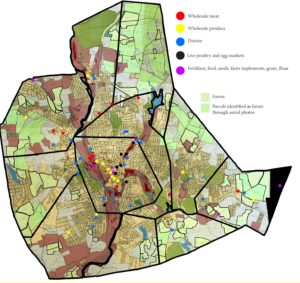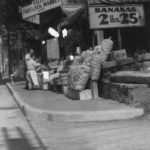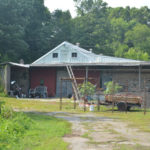This article is part of the digital exhibit Brass City/Grass Roots: The Persistence of Farming in Waterbury, Connecticut. Use the arrows at the bottom of the page to navigate to other parts of the exhibit.
Waterbury also had a thriving local food processing/marketing sector. Even towards the middle of the 20th century, Waterbury’s neighborhoods were replete with live chicken markets, produce wholesalers, dairies, cattle dealers, and door-to-door food peddlers.
The city government became increasingly involved in regulating and supporting local food production. In the late 19th or early 20th century, the city established a municipal slaughterhouse to which local farmers brought their animals to be killed, processed, and inspected. The city also fostered the sale of produce by local farmers by sponsoring a municipal farmers’ market, starting in 1917 in the Bank and Meadow Street area.
Most wholesale fruit and vegetable dealers, meat processors, fertilizer makers, and vendors of farm equipment and supplies located themselves near the railroad. The Freight/Meadow/Canal Street area had many wholesale operations. Across West Main Street in the Sperry Street area was a mini-meat-packing district. Here branches of national companies clustered with local meat providers.

Map from 1932 with colored dots showing different types of businesses related to agricultural marketing – Map courtesy of David Perrier, click to enlarge
- In 1917, one of the first in the state, Waterbury’s municipal farmers’ market provided a place for area farmers to sell produce to wholesalers, stores, and city residents – Photo courtesy of the University of Connecticut, click to enlarge
- The Gagliardi family, Buck’s Hill farmers, had a slaughterhouse in the building that still stands on Buck’s Hill Road – Photo courtesy of Georgia Sheron, click to enlarge
- Gaetano Calli and his sons went from peddling to opening their own produce stores, like this one on South Main Street – Photo courtesy of Tony Calli, click to enlarge
- The Becces built this slaughterhouse on their Farmwood Road farm. After the flood of ’55, the Porzios rented and expanded it – Photo courtesy of Georgia Sheron, click to enlarge
Several local families started out farming, then went into wholesale or retail meat marketing. The Antonelli family, for example, farmed in the early 20th century in lower Litchfield County. They became butchers and meat peddlers, establishing several retail stores in Waterbury. Their cousins, the Porzios, who specialized in veal, went to livestock auctions and brought calves back to Waterbury’s municipal slaughterhouse, where they processed the animals on an almost-daily basis. They delivered locally to stores and restaurants and eventually to supermarket chains. After the flood of 1955 washed out the city slaughterhouse, they rented the Becces’ slaughterhouse and continued their business there.
Produce peddling was an excellent way for immigrants limited in English and funds to start a business. Gaetano Calli arrived in the United States from Messina, Sicily in 1912. After a short stint at the Scovill factory he began selling produce door to door, gradually opening several stores. As his three sons grew they became peddlers too and founded their own stores.
Italian immigrant families came down to area fruit wholesalers during wine-making season; it was practically a community event when the train came in the early fall bearing grapes from California. Indeed, wine-making remains one of the last holdovers of Waterbury’s agricultural operations.
Other Waterbury families farmed even after World War II. Candida and John DeLaurentis, both children of Italian immigrants, had been working in local brass factories when they decided (in 1945) to start their own poultry business, raising chickens and eggs on their two acres of Long Hill property.
As demand grew, the DeLaurentises bought additional eggs and chickens from other farmers and opened a retail market in Town Plot, with extended family members as employees. JD Market, like other Waterbury poultry markets, featured live birds: Theresa DeLaurentis, Candida and John’s daughter, remembers: “[The customers] picked out their chicken, their turkey out of the window in the front, and [the workers] would slaughter them in the back room.”
Note: ConnecticutHistory.org does not edit content originally published on another platform and therefore does not update any instances of outdated content or language.
<< Previous – Home – Next >>













